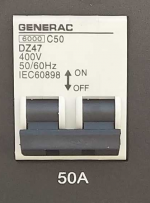I'm designing a backup system for (2) 2HP motors. Both motors have an inrush current of 54 amps.
I looked into one of generac's portable 17500W generator which says it could handle up to 26250 starting watts and 17500 running watts. The generator has a 50A internal circuit breaker which feeds a 50A outlet. I want to utilize this outlet to feed the (2) 2hp motors but not sure if the internal 50A circuit breaker could handle it due to inrush. There's no information on the time characteristic curve for that 50A circuit breaker for me to refer to. I am not sure if the starting watts applies to the internal 50A circuit breaker because it has many other addition outputs.
I want to ask the manufacturer but it's hard to get a hold of them, see cut sheet below.
https://www.generac.com/generaccorp...onal-power/gp series/0196640-a-gp17500e_1.pdf
thank you.
I looked into one of generac's portable 17500W generator which says it could handle up to 26250 starting watts and 17500 running watts. The generator has a 50A internal circuit breaker which feeds a 50A outlet. I want to utilize this outlet to feed the (2) 2hp motors but not sure if the internal 50A circuit breaker could handle it due to inrush. There's no information on the time characteristic curve for that 50A circuit breaker for me to refer to. I am not sure if the starting watts applies to the internal 50A circuit breaker because it has many other addition outputs.
I want to ask the manufacturer but it's hard to get a hold of them, see cut sheet below.
https://www.generac.com/generaccorp...onal-power/gp series/0196640-a-gp17500e_1.pdf
thank you.

